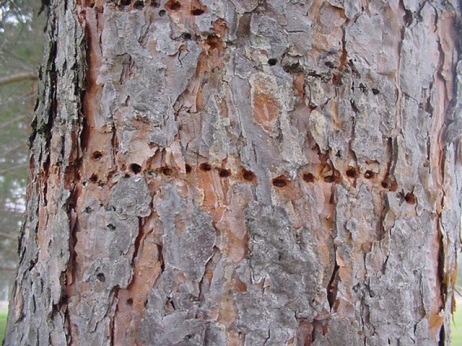Sapsucker feeding habits benefit overall forest ecology
Although looked at as damaging by some, sapsucker injuries to trees are used to the benefit migratory birds and several other wildlife species with little negative effect on tree health.
One of the telltale signs of spring at many Michigan State University Extension offices are calls inquiring as to what is causing rows of holes in tree trunks. Usually, unless they see the culprit in action, individuals assume it’s some kind of “insect damage.” In reality those rows of uniform holes are most often being drilled into the bark by yellow-bellied sapsuckers (Sphrapicus varius).
Although the sapsuckers feed on a variety of insects and berries, when other food sources are in short supply they will drill holes through the bark creating a wound which causes sap to collect. The birds will then feed on this sap. The holes only go in far enough to encourage sap to collect or flow and healthy trees grow over or seal these holes rather quickly. Therefore, this activity does not pose too much of a health threat to the trees.

Sapsucker damage to trunk of tree.
However, sapsucker damage can cause economic loss in higher valued trees. The drilling and healing activity results in bark pockets being formed. These small pockets of bark are generally referred to as “bird peck” in lumber and veneer, and can dramatically lower their value.
In sugar maple stands, in addition to the holes, sapsucker activity is often evidenced by trees with the whole trunk appearing black in color. Feeding birds tend to visit the same tree repeatedly. Sap oozing from the wounds in maple, which has a high sugar component, promotes the growth of dark-colored fungi giving the trees a sooty black appearance from a distance.
In contrast to the minor damage sapsuckers can cause, at least 35 species of birds including the Ruby-throated Hummingbird are associated with sapsucker-damaged trees. Hummingbirds will migrate with the sapsuckers to take advantage of the sap pockets they manufacture and have even been observed following sapsuckers from tree to tree. Insects and animals, including squirrels, porcupines, ants, hornets and wasps among others are also attracted to this sap food source.
To fully appreciate the wonders of the forests one only needs to get out and spend some time observing in Michigan’s expansive forest resources.
For more details on the forest/wildlife complex visit the Michigan’s Forests Forever Teachers Guide section of wildlife ecology basics.



 Print
Print Email
Email



